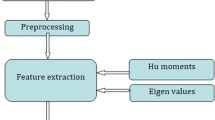Abstract
This paper proposes the performance of a new algorithm for recognition vehicle’s system. This recognition system is based on extracted features on the performance of image’s curvelet transform & achieving standard deviation of curvelet coefficients matrix in different scales & various orientations. The curvelet transform is a multiscale transform with frame elements indexed by location, scale and orientation parameters, and have time-frequency localization properties of wavelets but also shows a very high degree of directionality and anisotropy.The used classifier in this paper is called k nearest-neighbor.In addition, the proposed recognition system is obtained by using different scales information as feature vector. So, we could clarify the most important scales in aspect of having useful information. The results of this test show, the right recognition rate of vehicle’s model in this recognition system, at the time of using the total scales information numbers 2,3&4 curvelet coefficients matrix is about 95%. We’ve gathered a data set that includes of 300 images from 5 different classes of vehicles. These 5 classes of vehicles include of: PEUGEOT 206, PEUGEOT 405, Pride, RENULT5 and Peykan. We’ve examined 230 pictures as our train data set and 70 pictures as our test data set.
Access this chapter
Tax calculation will be finalised at checkout
Purchases are for personal use only
Preview
Unable to display preview. Download preview PDF.
Similar content being viewed by others
References
MP. Dubuisson-Jolly, S. Lakshmanan, and A. Jain. Vehicle segmentation and classification using deformable templates. IEEE Transactions Pattern Analysis and Machine Intelligence, 18(3):293–308, 1996.
J. Ferryman, A . Worral, G. Sulliva, and K. Baker.A generic deformable model for vehicle recognition. In British Machine Vision Conference, pages 127–136. British Machine Vision Association, 1995.
W. Wei, Q. Zhang, and M. Wang. A method of vehicle classification using models and neural networks. In IEEE Vehicular Technology Conference. IEEE, 2001.
E.J. Candes, D.L. Donoho,“Curvelets - A surprisingly effective nonadaptive representation for objects with edges”, Curve and Surface Fitting, Vanderbilt Univ.Press 1999.
T. Kato, Y. Ninomiya, and I. Masaki. Preceding vehicle recognition based on learning from sample images. IEEE Transactions on Intelligent Transportation Systems, 3(4):252–260, 2002.
A. Lai, G. Fung, and N Yung. Vehicle type classification from visual-based dimension estimation. In IEEE Intelligent Transportation Systems Conference, pages 201–206. IEEE, 2001.
N. Matthews, P. An, D. Charnley, and C. Harris. Vehicle detection and recognition in greyscale imagery. Control Engineering Practice, 4(4):472–479, 1996.
V.S.Petrovic and T.F.Cootes. Analysis of Features for Rigid Structure Vehicle Type Recognition.2003.
Video-based Car Surveillance: License Plate, Make, and Model Recognition,Thesis , Masters of Science in Computer Science University of California, San Diego, 2005.
E.J. Candes, D.L. Donoho,“New Tight Frames of Curvelets and Optimal Representations of Objects with Smooth Singularities”, Technical Report, Stanford University, 2002.
D.L. Donoho,“De-noising by soft-thresholding”, IEEE Transactions on Information Theory, 1995.
B.S. Kashin, V.N. Temlyakov,“On best m-term approximations and the entropy of sets in the space L1” Mathematical Notes 56, 1137-1157, 1994.
E.J. Candes, L. Demanet, D.L. Donoho, L. Ying,“Fast Discrete Curvelet Transforms” Technical Report, Cal Tech, 2005.
S. Theodoridis, K. Koutroumbas, Pattern Recognition, Academic Press, New York, 1999.
F. M.Kazemi, S. Samadi,“Vehicle Recognition Based on Fourier, Wavelet and Curvelet Transforms - a Comparative Study,” IEEE, International Conference on Information Technology (ITNG’07), USA, pp. 939-940, 2007.
F. M.Kazemi, S. Samadi “Vehicle Recognition Based on Fourier, Wavelet and Curvelet Transforms - a Comparative Study” , IJCSNS International Journal of Computer Science and Network Security, VOL.7 No.2, pp. 130-135, 2007.
Author information
Authors and Affiliations
Editor information
Editors and Affiliations
Rights and permissions
Copyright information
© 2008 Springer Science+Business Media B.V.
About this paper
Cite this paper
Kazemi, F.M., Pourreza, H.R., Moravejian, R., Kazemi, E.M. (2008). Vehicle Recognition Using Curvelet Transform and Thresholding. In: Sobh, T. (eds) Advances in Computer and Information Sciences and Engineering. Springer, Dordrecht. https://doi.org/10.1007/978-1-4020-8741-7_26
Download citation
DOI: https://doi.org/10.1007/978-1-4020-8741-7_26
Publisher Name: Springer, Dordrecht
Print ISBN: 978-1-4020-8740-0
Online ISBN: 978-1-4020-8741-7
eBook Packages: Computer ScienceComputer Science (R0)




